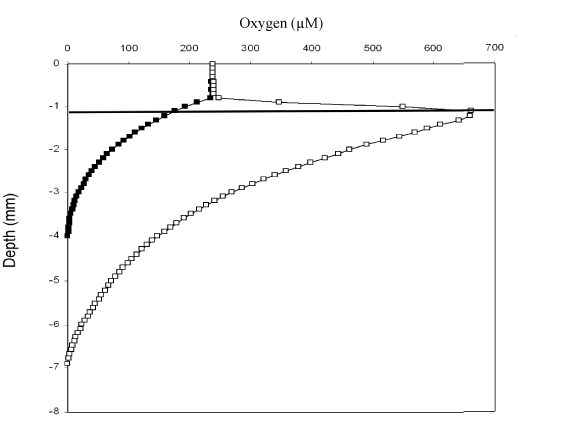


 |  |  | 12.2 Benthic production |

In coastal areas with light exposed sediments diatoms and/or cyanobacteria covers the sediment surface. Here they exploit the nutrients released by the degradation processes occurring in the deeper sediment layers (see below). Thereby they actually put a lid on the sediment depriving the primary producers in the water column a nutrient source. The volumetric photosynthetic activity in these compact communities can be huge and can easily match the integrated activity of the water column. In areas with significant benthic photosynthesis the production and degradation of organic material is tightly coupled spatially and temporally. There exists an almost mutualistic symbiosis were phototrophs leaks low-molecular organic compounds to the aerobic heterotrophic community that on the other hand lower the O2 concentration (and the pH) and release CO2 lowering the photosynthetic stress on the phototrophic community. The dissolved organic material is thereby maintained within the benthic environment. Such communities are of course an excellent food source and are exposed to heavy metazoan grazing keeping the benthic microbial biomass low. Experiments have shown that by eliminating grazing the benthic phototrophic communities quickly grow to an extensive thickness effeiciently absoping nutrients release from the deeper sediment strata. Fixed to the sediment surface the benthic phototrophic community is vulnerable to changes in water turbidity or pelagic blooms impeding the down welling irradiance.
In shallow oligotrophic areas the benthic primary production often dominates the ecosystem. As nutrient loading increases, the advantage of being close to the benthic nutrient source diminish and the pelagic growth limits the light availability. Therefore the ecosystem primary production shift from being dominated by benthic phototrophs in oligotrophic area to pelagic dominated systems in eutrophicated areas. In many temperate coastal areas a similar shift is often seen on a seasonal basis. During late autumn and winter the water is clear, nutrient concentration relatively low and a mixed water column favors a benthic production. However, as water column stratifies during spring (and the nutrient concentration increases) the following pelagic spring bloom shade out the benthic production. During autumn, metazoan grazing decrease, the water column clears and benthic microphytic photosynthesis again becomes important on ecosystem level.
The benthic microphytes compete with the bacterial community for nutrients in order to sustain the metabolic activity. Nitrogen, primarily in the form of NH4+, is produced during the anaerobic degradation in the deeper sediment strata (see below). Within the oxic zone nitrifying bacteria oxidize ammonia to nitrate and harvest the released energy according to the following stochiometry: NH4+ + O2 -> NO3-. In realty two synthropically coupled groups of bacteria are involved in this process. In many oligotrophic coastal settings microphytes competes successfully with nitrifyers for the ammonia. In such areas the nitrification is almost excluded, while photosynthesis and nitrification coexist in eutrophicated areas with higher concentrations of nutrients. Actually the photosynthetic activity stimulates nitrification in nutrient rich environments due to the broader oxic zone. The benthic microphytes thereby indirectly regulate the activity of the denitrifying community that use nitrate as an oxidant for their heterotrophic metabolism in the anoxic parts of the sediment (see below).
Elevated nutrient concentrations in the water column, stimulates the pelagic production and the light limited benthic microphytic community can be out competed. In those cases nitrification in the sediment gets reduced and a larger fraction of nitrogen leaves the sediment in the form of ammonium. Denitrification is then mainly based on nitrate from the overlying water diffusing down through the oxic zone. If the environment gets further reduced the reduction of nitrate becomes dominated by `dissimilativ of nitrate to ammonium' and the removal of nutrients through denitrification ceases. Such transitions are often observed around aquaculture plants with localized eutrophication (e.g. Chistensen et al. [90]).
 |  |  | 12.2 Benthic production |